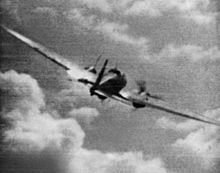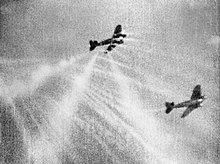No. 609 Squadron RAF
| No. 609 (West Riding) Squadron RAuxAF | ||
|---|---|---|
Honorary Air Commodore Geoffrey Ambler | | |
| Notable commanders | Roland Beamont | |
| Insignia | ||
| Squadron Badge | In front of two hunting horns in saltire, a rose | |
| Post 1951 Squadron markings[1] |  | |
| Squadron Codes | BL (Apr 1939 – Sep 1939)[2] PR (Sep 1939 – Sep 1945 and 1949 – Apr 1951)[3] RAP (May 1946 – 1949)[4] | |
No. 609 (West Riding) Squadron of the Royal Auxiliary Air Force, originally formed as a bomber squadron and in the Second World War active as fighter squadron, nowadays provides personnel to augment and support the operations of the Royal Air Force. The squadron is no longer a flying squadron, but instead has the role of Force Protection. It is currently based at RAF Leeming, North Yorkshire.
History
Formation and early history (1936–1939)
No. 609 Squadron was formed on 10 February 1936 at
Second World War


At the outbreak of war, the squadron was called up to full-time service and initially served on defensive duties in the North of England. In May 1940, the squadron moved to
During the
During February 1941 the squadron moved to
While at Biggin Hill, the squadron acquired a goat, soon named William, which became their official mascot.[11] He was awarded an honorary DSO and DFC, and the rank of Air Commodore.[11]

In spring 1942 the squadron moved to
Prior to the allied
Post-war period (1945–1957)
After the war, 609 Squadron was stood down, and the name transferred back to the Royal Auxiliary Air Force. In 1946, the squadron reformed at RAF Church Fenton, then moved back to Yeadon. 609 was once again a squadron manned by part-time civilians using front line fighters, this time the Mosquito NF.30 night-fighter and later, when the squadron changed role to that of a daylight fighter squadron, the Spitfire LF.16. In 1951, 609 Squadron re-equipped with jet fighter aircraft, the Gloster Meteor, and moved back to Church Fenton in order to take advantage of the longer runway. At this time, 19 regular squadrons and 10 reserve squadrons of Meteors formed Britains main fighter defence. During the Korean War, 609 and other auxiliary squadrons were called up to full-time service for 3 months.
From 1947 to March 1957 (when all flying squadrons of the Royal Auxiliary Air Force were disbanded), Air Vice-Marshal
The modern era (2000–present day)
The latest incarnation of the squadron was formed at RAF Leeming on 1 July 1998 and was originally named the Air Defence Support Squadron, the 609 number plate was granted on 1 October 1999. The squadron is no longer a flying Squadron, but instead has the role of Force Protection, it is employed to prevent or minimise the effects of enemy attack on RAF bases. The Squadron was deployed to
609 Squadron in art
Due to the exploits of 609 Squadron during the Second World War, its aircraft have been depicted in a number of paintings. These include:
- Southern Patrol, by Philip West, showing both 609 and 152 Squadron patrolling over the south coast of England.
- Spitfire Tally-Ho, by Geoffrey Lea (note that Tally-Ho is the Squadron motto).
- Supermarine Spitfire Mk I, by Philip West.
- Into the blue, by Simon Atack.
- Height of the Battle, by Geoff Nutkins. Showing John Dundas & Red Tobin in combat.
- Lone Patrol, by John Young. Showing Spifire Mk I, X4590 the aircraft now preserved at the RAF Museum, Hendon.
- 609 Squadron's 200th, by Geoff Nutkins.
- Typhoon Scramble, by Richard Taylor.
- Typhoon Attack, by Robert Taylor.
- Double Trouble, by Geoff Nutkins.
- Sorbo Leader Attacking, by Alex Hamilton. Showing Pilot Officer N.Le C.Agazarian in Spitfire PR-U R6915.
- Battle above the Clouds, by Geoff Nutkins. Showing John Dundas shooting down German ace Helmut Wick.
Aircraft operated
| From | To | Aircraft | Version |
|---|---|---|---|
| June 1936 | January 1938 | Hawker Hart | |
| January 1938 | August 1939 | Hawker Hind | |
| August 1939 | May 1941 | Supermarine Spitfire | Mk.I |
| February 1941 | May 1941 | Supermarine Spitfire | Mk.IIa |
| May 1941 | May 1942 | Supermarine Spitfire | Mks.Vb, Vc |
| April 1942 | 1942 | Hawker Typhoon | Mk.Ia |
| May 1942 | September 1945 | Hawker Typhoon | Mk.Ib |
| July 1946 | April 1948 | de Havilland Mosquito | NF.30 |
| April 1948 | February 1951 | Supermarine Spitfire | LF.16e |
| November 1950 | January 1951 | de Havilland Vampire | FB.5 |
| January 1951 | July 1951 | Gloster Meteor | F.4 |
| June 1951 | February 1957 | Gloster Meteor | F.8 |
Commanding officers
| From | To | Name |
|---|---|---|
| 10 February 1936 | 8 December 1938 | Sqn Ldr H. Peake |
| 8 December 1938 | 28 December 1939 | S/Ldr. G.H. Ambler, AFC |
| 28 December 1939 | 28 June 1940 | S/Ldr. M.T. Avent |
| 28 June 1940 | 4 October 1940 | S/Ldr. H.S. Darley, DSO |
| 4 October 1940 | 29 July 1941 | S/Ldr. M.L. Robinson, DSO, DFC |
| 29 July 1941 | 1 June 1942 | S/Ldr. G.K. Gilroy, DSO, DFC & Bar |
| 1 June 1942 | 30 October 1942 | S/Ldr. P.H.M. Richey, DFC & Bar |
| 30 October 1942 | 5 May 1943 | S/Ldr. R.P. Beamont, DSO, DFC & Bar |
| 5 May 1943 | 18 August 1943 | S/Ldr. A. Ingle, DFC, AFC |
| 18 August 1943 | 29 December 1943 | S/Ldr. P.G. Thornton-Brown, DFC |
| 29 December 1943 | 30 June 1944 | S/Ldr. J.C. Wells, DFC |
| 30 June 1944 | 14 August 1944 | S/Ldr. L.E.J.M. Geerts, DFC |
| 14 August 1944 | 17 September 1944 | S/Ldr. R.A. Lallemant, DFC & Bar |
| 17 September 1944 | 14 November 1944 | S/Ldr. T.Y. Wallace, DFM |
| 14 November 1944 | 6 December 1944 | S/Ldr. C.J.G. "Windmill" Demoulin, DFC |
| 6 December 1944 | 16 March 1945 | S/Ldr. E.R.A. Roberts, DFC |
| 16 March 1945 | 15 September 1945 | S/Ldr. L.W.F. Stark, DFC & Bar, AFC |
| 10 May 1946 | January 1950 | S/Ldr. P.H. Womersley, DFC & Bar |
| January 1950 | December 1953 | S/Ldr. A. Hudson, DFC, AFC |
| December 1953 | January 1956 | S/Ldr. E.T. Evans |
| January 1956 | 10 March 1957 | S/Ldr. D. Shaw |
See also
References
Notes
- ^ "Squadron Aircraft & Markings". rafweb.org. Archived from the original on 6 September 2012.
- ^ Bowyer & Rawlings 1979, p. 14.
- ^ Bowyer & Rawlings 1979, p. 83.
- ^ Bowyer & Rawlings 1979, p. 138.
- ^ Hunt 1972, pp. 195–227.
- ISBN 978-0-00-653204-0.
- ^ a b Mason Battle Over Britain p.412
- ^ "No. 34984". The London Gazette. 1 November 1940. pp. 6348–6349.
- ^ "SPITFIRE/X4590". Warbirds Resource Group. Retrieved 23 June 2012.
- ^ "Spitfire/R6915". Warbirds Resource Group. Retrieved 16 February 2012.
- ^ a b c "Yorkshire". How We Won the War. Series 1. Episode 4. 27 September 2012. BBC.
- ^ "Ken Adam's Protected Mode (Pt. I)". www.aggregat456.com. Archived from the original on 23 January 2015. Retrieved 25 April 2009.
- ^ 'Aces High', Shores & Williams, page 75
- ^ "G H Ambler_P". www.rafweb.org.
- ^ Moyes 1976, p. 279.
- ^ Rawlings 1978, pp. 493–494.
- ^ Halley 1988, p. 426.
- ^ Jefford 2001, p. 100.
- ^ Ziegler 1971, p. 335.
- ^ Rawlings 1978, p. 494.
Bibliography
- Bowyer, Michael J.F.; Rawlings, John D.R. (1979). Squadron Codes, 1937–56. Cambridge, UK: Patrick Stephens Ltd. ISBN 0-85059-364-6.
- Halley, James J. (1980). The Squadrons of the Royal Air Force. Tonbridge, Kent, UK: Air-Britain (Historians) Ltd. ISBN 0-85130-083-9.
- Halley, James J. (1988). The Squadrons of the Royal Air Force & Commonwealth, 1918–1988. Tonbridge, Kent, UK: Air-Britain (Historians) Ltd. ISBN 0-85130-164-9.
- Hunt, Leslie (1972). Twenty-One Squadrons: The History of the Royal Auxiliary Air Force, 1925–1957. London: Garnstone Press. ISBN 0-85511-110-0.
- Jefford, C.G. (2001). RAF Squadrons, a Comprehensive record of the Movement and Equipment of all RAF Squadrons and their Antecedents since 1912 (2nd ed.). Shrewsbury, Shropshire, UK: Airlife Publishing Ltd. ISBN 1-85310-053-6.
- Moyes, Philip J.R. (1976). Bomber Squadrons of the RAF and their Aircraft. London: Macdonald and Jane's (Publishers) Ltd. ISBN 0-354-01027-1.
- Rawlings, John (1978) [1969]. Fighter Squadrons of the RAF and their Aircraft (Revised ed.). London: Macdonald and Jane's Publishers Ltd. ISBN 0-354-01028-X.
Books by members of 609 Squadron
- Bell, George Armour. To Live Among Heroes. London: Grub Street Publishing. ISBN 1-902304-80-2. George Bell served as a medical officer with 609 Squadron. This book details the experiences of the Squadron in 1944 and 1945.
- Faber and Faber. His autobiography.
- Crook, David Moore (1946). Pursuit of Passy, Herbert Joseph. A novel.
- DeMoulin, Charles (1982). Mes Oiseaux De Feu (in French). Julliard/France Loisirs. Belgian pilot of the 609 Squadron (1941–1945), he became Squadron Leader in 1944.
- Translated as Firebirds! Flying the Typhoon in Action. Shrewsbury, Shropshire, UK: Airlife Publishing Ltd., 1987. ISBN 0-906393-48-5.
- Translated as Firebirds! Flying the Typhoon in Action. Shrewsbury, Shropshire, UK: Airlife Publishing Ltd., 1987.
- Earnshaw, James Douglas. 609 at War. Vector Fine Art. ISBN 0-9545179-0-3.
- Lallemant, Lt. Colonel R. (1962). Rendez-vous avec la chance (in French). Paris: Robert Laffont. Raymond Lallemant was a pilot of the free Belgian forces who flew with the RAF's 609 squadron. The work is written in French.
- Ziegler, Frank H. (1971). The Story of 609 Squadron: Under the White Rose. London: Macdonald. ISBN 0-356-03641-3.
- Second edition as The Story of 609 Squadron: Under the White Rose. London: Crécy Publishing Ltd., 1993. ISBN 0-947554-29-7. Ziegler was an intelligence officer with 609 Squadron.
- Second edition as The Story of 609 Squadron: Under the White Rose. London: Crécy Publishing Ltd., 1993.
- Waite, Brian (2008). William De Goat. Athena Press. ISBN 978-1-84748-283-9. Squadron Leader Brian Waite was the O.C. of 609 Sqn. (2001–06) and this is his story of Air Commodore William De Goat, DSO, DFC, the extraordinary Mascot of 609 (West Riding) Squadron during the Second World War.
External links
- 609 RAuXAF
- Battle of Britain history of No. 609 Squadron
- Battle of Britain pictures of No. 609 Squadron
- Official history No. 609 Squadron
- Current 609 Squadron Website
- No. 609 Squadron living history group
- 609 Squadron photos
- Aircraft and marking of no. 609 sqn
- Official Site of the Royal Auxiliary Air Force (RAF Reserves)
